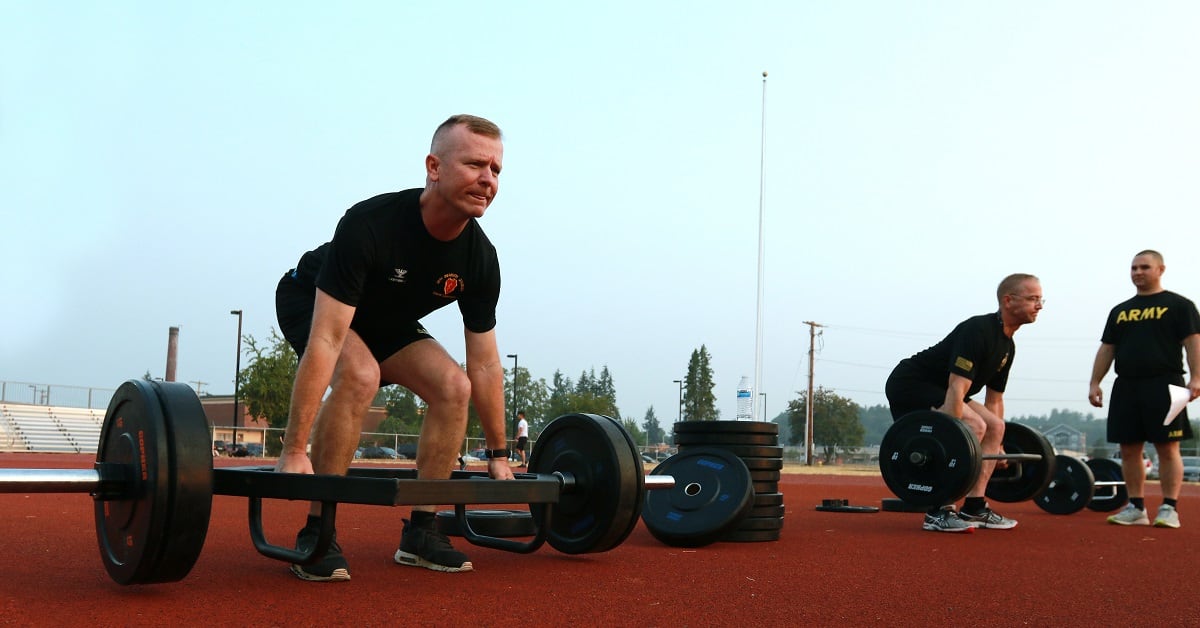The forthcoming Army Combat Fitness Test requires a good deal more space and equipment than its predecessor, which will make it a lot harder to conduct a fitness test at a small combat outpost on a mountainside in, for instance, Afghanistan.
Two West Point instructors have a possible answer to that issue, which they outlined in a piece published by the academy’s Modern War Institute on Dec. 7.
“What about the special operators, foreign area officers, and soldiers assigned to remote locations or any of the 800 small bases abroad?” Maj. Zachary Griffiths and Capt. Andrew Ferreira ask.
Griffiths, a Special Forces officer currently serving as an instructor in the social sciences department, is a fellow at MWI. Ferreira, an infantry officer, is a survival swimming instructor in the physical education department.
“This test stresses similar movements and energy systems, but removes space and equipment requirements that will make the ACFT impossible for some units to execute,” they wrote, proposing a six-event alternative that can be done with limited equipment and space:
- Three-rep deadlift with a straight bar, rather than a hexagon-shaped one.
- Standing broad jump, rather than a standing power throw.
- Hand-release push-ups, same as before.
- A modified sprint-drag-carry, with dumb bells or other 40-lb items instead of kettle bells.
- Leg tuck, same as before.
- Twenty-meter multistage shuttle run, rather than a two-mile run.
The two were inspired by Army marksmanship, which has a back-up qualification test specifically for soldiers who need to qualify in environments where it isn’t feasible to set up a full “Trainfire” range.
Army leadership did consider the logistical challenge of putting on an ACFT on small-scale deployments, Sergeant Major of the Army Dan Dailey told Army Times on Dec. 12, but the solution was to re-write the fitness regulation to give units a pass.
“I just submitted the change,” Dailey said. “It’s not approved yet. I’m giving commanders the flexibility to conduct the ACFT or APFT [Army Physical Fitness Test] in an environment that they feel is conducive to them doing so.”
So if there’s no space, a commander can opt out of conducting a PT test. They’ll also get a grace period when they return from deployment, Dailey added.
As soon as the change is approved, units in austere environments won’t have to do the current Army Physical Fitness Test, and that will carry over to the new ACFT.
“I’m not saying that paper doesn’t have merit,” Dailey said of the MWI piece. “It’s a great conversation. But we have thought about it.”
Since the Center for Initial Military Training unveiled the new six-event Army Combat Fitness Test in July, many questions about training, equipping and setting aside the time and space for the ACFT have popped up.
What about National Guard units, with limited drill hours for PT, and perhaps with soldiers based in rural areas without access to pull-up bars or medicine balls? What about soldiers with injuries, who might need an alternate event to avoid aggravating them?
RELATED

“We should not adjust the standards ― period,” Dailey said of the idea of an alternate test for austere environments. “We do it, or we don’t. And if we do it, we do it to standard. And if we don’t, we’ll be okay.”
Instead, the plan is to get rid of a PT test as an administrative requirement when a unit has bigger priorities on a deployment.
“I trust those commanders and first sergeants and company commands and battalion [command sergeants major] to be able to maintain fitness in a theater of operation,” he said. “I’m not saying not to do PT.”
And, anecdotally, he added, leadership hasn’t seen any evidence that skipping a PT test will degrade physical fitness during a deployment.
“Those soldiers all still come back and do PT at night,” Dailey said. “If the environment requires [an exception], then I want them focused on the fight.”
Meghann Myers is the Pentagon bureau chief at Military Times. She covers operations, policy, personnel, leadership and other issues affecting service members.



